Animals With A Big Mission- How Animal-Assisted Therapy Helps Kids Build Connection
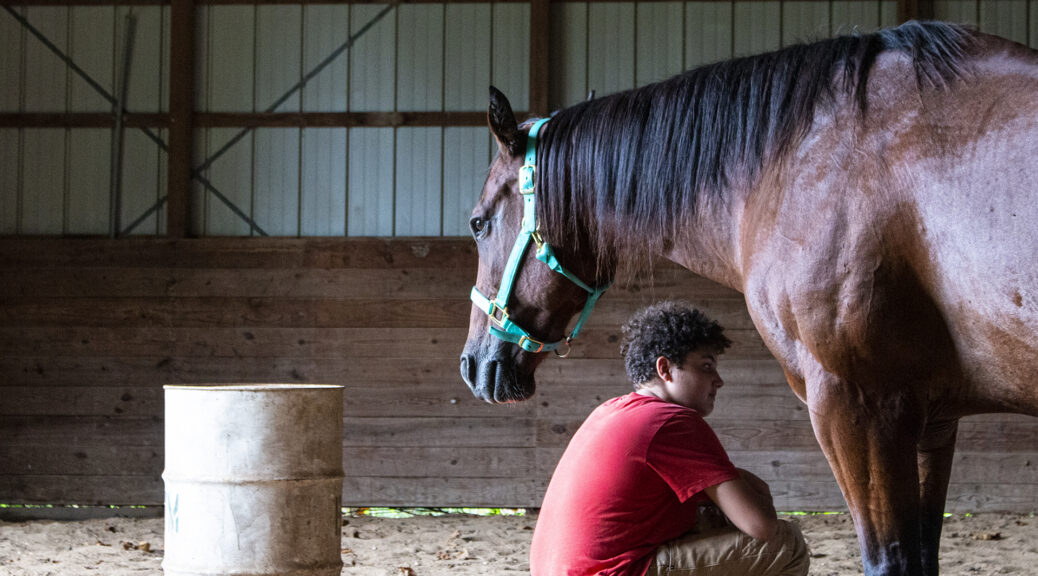
Animal-Assisted Therapy, how horses, goats and rabbits to deliver therapeutic experiences that help children achieve their full potential
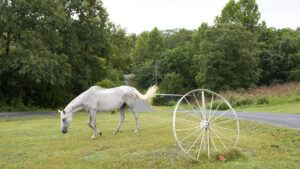 KVC Missouri’s Bottom-Up Stables in St. James is a special place where young people learn how to
KVC Missouri’s Bottom-Up Stables in St. James is a special place where young people learn how to
strengthen their human relationships by building close ones with animals.
The horses, goats, rabbits and other creatures have valuable lessons to teach KVC Missouri’s residential clients about boundaries, empathy, trust and respect, as well as managing emotions and building social communication skills, Equine Professional Debora “Debbie” Brooks says.
“All of the young residential clients who come to our stables have been through trauma of some kind,” says Brooks, who is also a youth care specialist. “They understand what survival mode looks like, just as animals often do.”
Animal-assisted therapy has proven effective for kids in need of emotional and behavioral health support. Rather than solely focusing on their behavior, Brooks says the focus is shared with the animal’s actions. This helps reduce self-consciousness while allowing kids to challenging themselves in fun ways to help achieve their full potential.
The kids typically visit the stable once a week. Brooks and her team start with group sessions where they talk about emotional and behavioral self-regulation.
“Kids learn that horses can sense when their heart rate is elevated. The horses won’t feel safe, and they won’t come around them,” she says. “It’s an important lesson in controlling mood and behavior that the kids must learn before we are able to move on to other tasks.”
Those tasks include leading the horses on a walk, as well as learning how to brush and groom them. These are rhythmic actions that are predictable and soothing for the kids. They promote calm and help the brain reorganize itself, Brooks says.
“Other lessons include how to interact with the horses and learn their boundaries. You wouldn’t get up close to the face of a person you don’t know. It’s the same with horses,” she says. “Kids learn how to ask for their trust and bond gradually with them. It takes time to build a relationship with an animal, just like with humans.”
Kids also learn to better control thoughts and behaviors during their visits to the stables. One of the ways therapists teach kids to calm their emotions is by having them do deep breathing exercises to the beat of a drum. The rhythmic breathing exercise helps create calm.
When the kids are with the horses, they can replicate the exercise by using the soothing sound of hooves on pavement to regulate their breathing and relax.
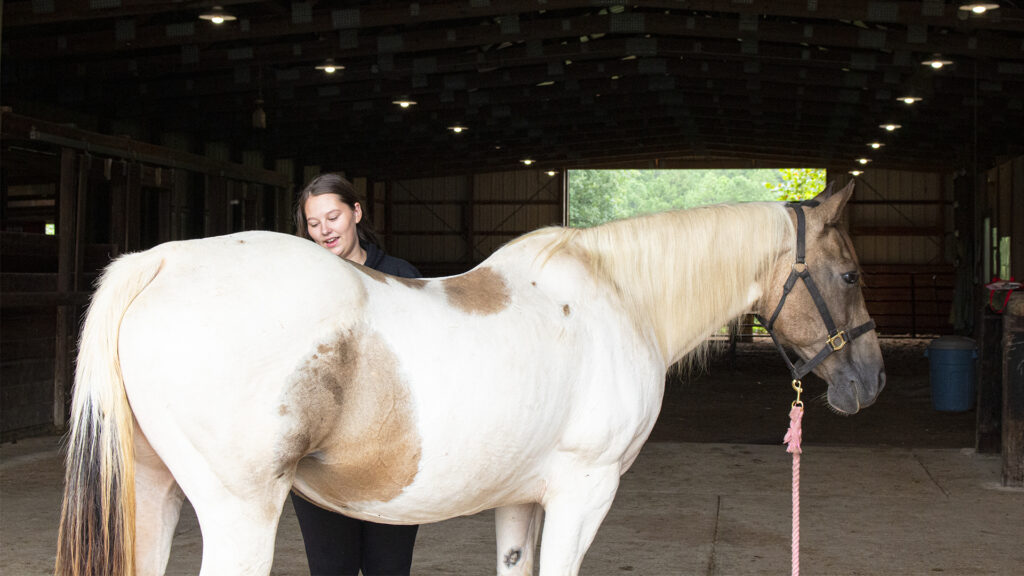
“It’s amazing what these simple techniques can do for the kids,” Brooks says. “Anger levels decrease. They’re able to think more calmly and rationally and make better choices. They also feel more relaxed, both mentally and physically.”
Many young clients have experienced domestic violence, affecting their ability to create and maintain relationships, Brooks says. She recalled how one girl with a difficult past became close to a miniature horse named Bruno, though he wasn’t initially receptive to her attention.
“Our therapist talked to her and discovered there were some aspects of her family situation that she hadn’t been able to open up about,” Brooks says. “We suggested that it might be helpful for her to design a constructive obstacle course and learn how to encourage Bruno to navigate it.”
She created a setup that represented some of the barriers and challenges she had faced in her own life, then worked with the animal to gain his trust so she could lead him through it.
“Her face lit up when she got him to cross the bridge she had made,” Brooks says.
Other animals like goats and rabbits help young clients learn healthy interaction and how to give and receive affection. Petting and playing with them and practicing deep breathing techniques are especially therapeutic.
“During one session, we had a group of young boys who were acting out. That made the animals feel agitated, as well,” Brooks says. “Our therapists were going to take the boys to work with the horses, but we decided a session with the goats should come first. The boys led the goats through the obstacle course and learned how to concentrate in ways that could help them regulate better.”
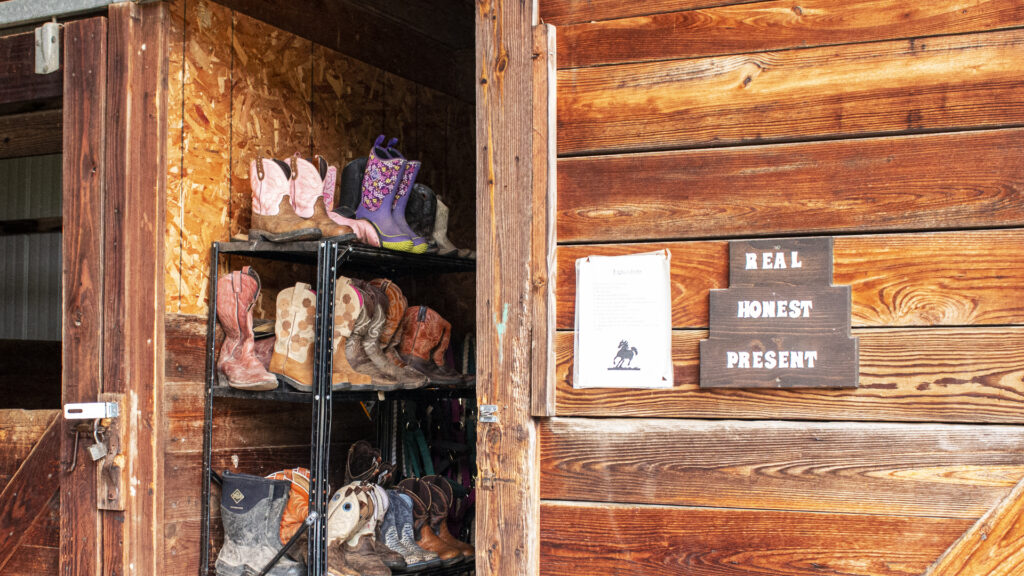
It also can be a learning experience when an older animal
reaches the end of its life.
“We cry and work through our emotions as a group when an animal dies,” Brooks says. “It can be intense, but it always ends in a positive way, with the kids realizing the value of caring about others during the time we have together.”
The most important takeaway of time spent at the stables is that a good relationship is based on patience, partnership and trust, not submission, coercion or appeasement, Brooks explains.
“Kids learn from the animals how to treat others as equals and practice fair give-and-take,” she says.
“It’s how they develop honesty and connection in a relationship.”
Another key lesson is the value of demanding work.
“It takes a lot of daily effort to keep the animals fed, watered, exercised and clean. That teaches discipline and the value of caring for living beings,” Brooks says.
It’s beneficial therapy, but kids will often comment that working with the animals doesn’t seem like therapy, she notes.
“We find that if they can build a healthy, trusting relationship with a horse, they can do it with a person,” she says. “It’s a lesson they carry with them forever.”
What can animals teach about human relationships?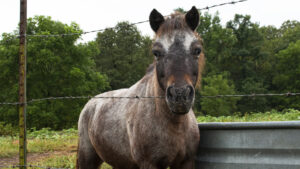
- It takes time to become comfortable with other people, just as it does with animals. Gradual, respectful interaction builds trust.
- Attending to the daily needs of an animal imparts lessons about commitment, consistency and self-care.
- Like people, animals respond best when the atmosphere is calm enough to make them feel safe.
- Healthy relationships are built on trust and equality, not submission or force.





